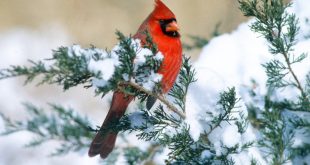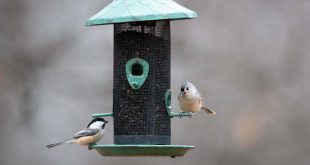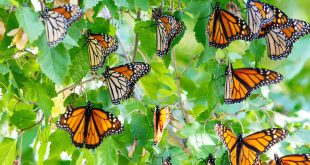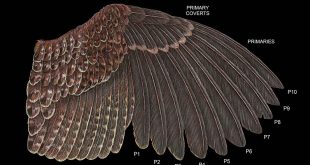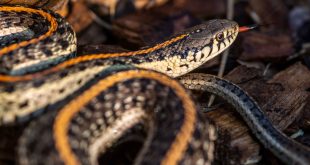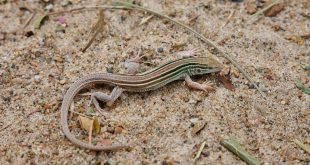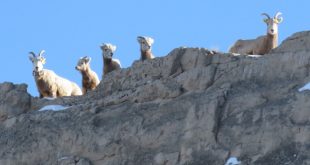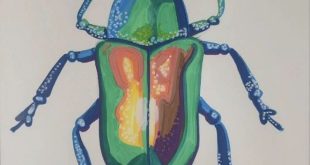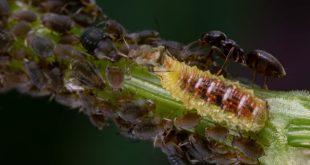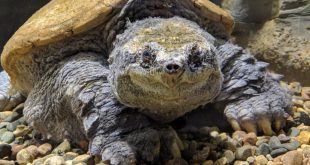This December, look for the color red in nature. By Alie Mayes, Community Science Specialist This article is part of the Nebraska Nature in Color series. This limited series will run monthly December 2023- June 2024. When contemplating the colors of December in Nebraska, the hues that come to mind are the browns of a sleepy landscape and the blanket of white that, at times, covers this seemingly barren terrain. But soon after, the color red also comes to mind, …
Read More »Wildlife Viewing in December
Watch for these signs of wildlife in winter. By Olivia DaRugna, Wildlife Diversity Biologist The cool, crisp air; the silent, still landscape; and fewer hours of daylight — winter offers a unique time to spend outdoors. While viewing wildlife can be difficult in winter, looking for signs of wildlife is not. Winter is a great time to look for clues – such as tracks, scat and old nests – and solve the mysteries of the animals that passed through the …
Read More »Where Do Insects Go in Winter?
Explore the fascinating ways insects survive through Nebraska’s harsh winters. By Monica Macoubrie, Wildlife Education Specialist For humans, winter means thick, fuzzy blankets, space heaters and hot chocolate to keep ourselves warm during the short, cold days. For many animals, winter is a time of change and adaptability, as temperatures dip and the amount of daylight gets shorter. For example, some animals migrate, some hibernate and others stay active throughout the season. Insects, however, have a few more creative strategies …
Read More »How to Age Quail In-Hand
Quail wing feathers can indicate a bird’s age, thus providing clues to maintaining high-quality habitat. By Kellie Hayden The features that make our favorite game birds so charismatic also provide details into the ages of these birds. When we read the clues that feathers hold, we can make smart decisions on maintaining high-quality habitat. Feathers take time and energy to grow — two things young birds don’t have much of when they need to quickly learn how to forage, fly …
Read More »A Guide to the Garter Snakes of Nebraska
Read about the four garter snake species of Nebraska. By Monica Macoubrie, Wildlife Education Specialist Most people don’t think about snakes in November, but with the near record high temperatures this year, some snakes are still slinking through the grasses or moving through our backyards in certain areas of Nebraska. One common inhabitant that you may still see lurking about your yard, soaking up the last warm rays of the fall, is the garter snake. No, not “garden snake” or …
Read More »Lizards of Nebraska
Four families of lizards can be found in Nebraska, with a total of 10 different species. By Monica Macoubrie, Wildlife Education Specialist Take a quick hike through the prairies of western Nebraska or the rocky terrain bordering Kansas, and you may see a scampering reptile with a long slender tail. Don’t panic — it’s not a snake. It’s just the most underrated reptile of all: lizards. With 6,000 species worldwide, one could say that lizards have been rather successful. They …
Read More »November Wildlife Viewing – Bighorn Sheep
November is a great time for viewing bighorn sheep in the Nebraska Panhandle. By Olivia DaRugna, Wildlife Diversity Biologist Before the 1900s, Audubon bighorn sheep inhabited parts of western Nebraska, including the Wildcat Hills, the Pine Ridge and along the North Platte River from the Wyoming state line to eastern Lincoln County. It was thought that the Audubon bighorn became extinct in the early 1900s, with its last stronghold being the South Dakota badlands. Since 1981, the Nebraska Game and …
Read More »The Art of Observation
Blend observation and art to appreciate the natural world. By Grace Gaard, Aquatic Ecology Education Specialist The month of October is notoriously busy no matter what you’re involved in: Hunting seasons begin, sports are in full swing, camping weather is wonderful, and everyone is soaking up the last of fall’s warmer weather. During this time of so much transition and activity, do you ever take a deep breath and slow down? As an artist and an outdoor enthusiast, I find …
Read More »Protecting the Flock – Ants and Aphids
Ants raise aphids to harvest their sugar-rich waste secretions known as honeydew. By Tyler Moore, Bellevue University With more than 15,000 described species of ants, as noted in “Bolton’s Catalogue of the Ants of the World,” these organisms are among the world’s most successful and represent a total estimated biomass of 12 megatons. They have also long been the subject of amateur naturalists and scientists, with perhaps no behavior more intriguing than the “farming” of aphids. Aphids are commonly known …
Read More »Meet Big Snap Daddy
Meet the star of Schramm Education Center. By Renae Blum Meet the star of Schramm Education Center’s aquarium, Big Snap Daddy. Weighing 98 pounds, he is considered the world’s largest common snapping turtle. He is also estimated to be over 90 years old. In the wild, common snapping turtles live an average of 30 years and grow to be about 35 pounds. Learn more about this remarkable creature from Schramm Park superintendent and aquarium director Tony Korth. How did Big …
Read More » Nebraskaland Magazine
Nebraskaland Magazine
